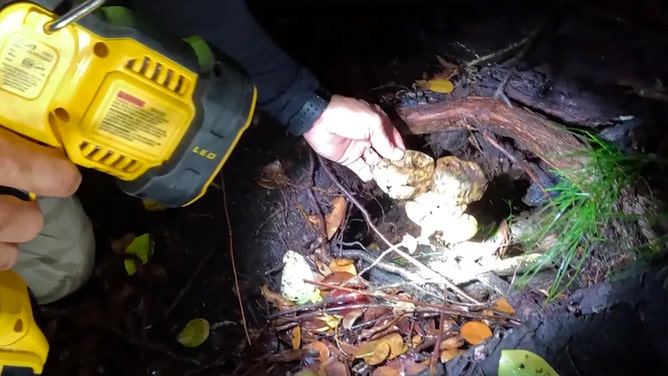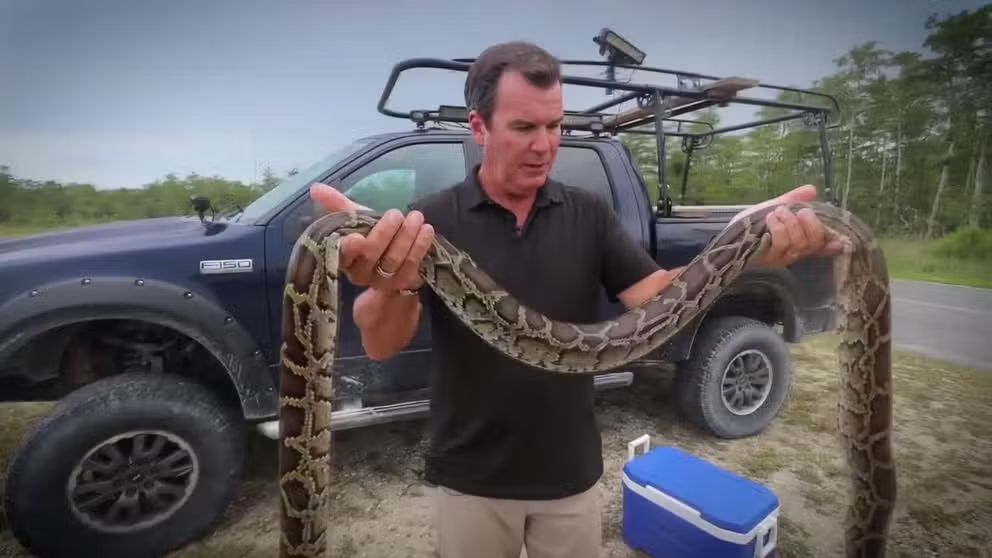Python hunter: Animal populations now critical in Florida Everglades
Burmese pythons are moving northward, likely searching for new food sources, as FOX 13's Mark Wilson recently learned when he joined the annual Florida Python Challenge with one of the state's top python hunters.
On the hunt for pythons in Florida
The invasive Burmese python is a serious threat to the Florida Everglades, preying on native species. Efforts are underway to remove as many as possible, as they also migrate north in search of new prey. FOX13's Mark Wilson joined expert python hunters for the Florida Python Challenge.
EVERGLADES, Fla. – The Burmese python is devouring many native species in the Florida Everglades, and now there's an all-out effort to remove as many as possible before it's too late.
They are moving northward, likely searching for new food sources, as FOX 13's Mark Wilson recently learned when he joined the annual Florida Python Challenge with one of the state's top python hunters.
"Once you find them, you can catch them if you know what you're doing. But finding them is absolutely the hardest part," said Brandon Rahe, who caught 40 pythons in July as a contractor licensed by the Florida Fish and Wildlife Commission and stays busy.
Rahe left a successful personal training business in St. Augustine to hunt pythons in the Everglades full-time.
He's among dozens of professional hunters participating in the state's annual hunt.
But it attracts just as many amateurs with varying degrees of experience as 75-year-old Davis Hariman, who Wilson met hunting by himself.
And while hunting them alone can be done, it's not recommended.
'IT WAS A FIGHT': HUNTERS CAPTURE 19-FOOT BURMESE PYTHON; LONGEST EVER RECORDED IN FLORIDA

Burmese pythons can be deadly if mishandled.
(FOX 13 News)
Burmese pythons are non-venomous; they will bite but are constrictors, so the larger ones can strangle you in an instant if you don't handle them carefully.
Native to Asia, several were released as pets in the ‘80s and early ’90s.
With no natural predators, they've feasted on a buffet of animals and have since had a devastating effect.
The U.S. Geological Survey reports that the bobcat population in the Everglades has dropped 87% since 1997, the possum population has dropped 98%, raccoons are down 99%, and foxes and rabbits have "effectively disappeared." Many consider it to be a critical situation for native animals.
"That's absolutely because of the pythons," Rahe told FOX 13's Mark Wilson.
"If we drove around at night 30 years ago like we're doing, we would see all the things you just mentioned, and you're not going to see any of that tonight. Yeah, it's (crisis mode) big time," said Rahe.
SEE IT: IOWA TARGET CUSTOMERS SHOCKED TO FIND HUGE EXOTIC SNAKE CURLED UP IN SHOPPING CART

The Everglades has seen a major decline in animal populations, with some species decreasing by as much as 99%.
(FOX 13 News)
As Rahe's YouTube channel shows, he's been busy. A handful of videos show him on the hunt, finding pythons of all sizes, notably a 16-footer he's hoping will help him win the state's Python Challenge.
Results from that competition are expected in October, but Rahe hopes to make an impact. He says he caught 40 pythons just in July; two were snakes on nests.
One of them set a state record with at least 111 eggs. "Understandably, she was feisty," he said.
Rahe found them all in the heart of Everglades National Park in South Florida, about an hour southeast of Naples.
That's where FOX 13's Mark Wilson met him to see the levee that runs through the park.
"We're playing the odds that we're going to catch one out and being active," Rahe said.
The pythons usually creep out of the water at night and journey up to land to feed. During Wilson and Rahe's five-hour hunt, they saw several native snakes and a feral hog but no pythons. They did notice the eerie quiet that falls over the Everglades at night, as they saw no other animals.
TEXAS WOMAN SIMULTANEOUSLY ATTACKED BY SNAKE, HAWK AFTER SNAKE 'FELL FROM THE SKY'

A group of eggs in a snake nest is called a clutch, usually containing newly hatched snakes.
(FOX 13 News)
When Wilson and Rahe high-stepped off-road for a few minutes, Rahe found a nest.
The nests, he says, are called clutches; inside it, he finds a handful of eggs from recent hatchlings. So he marked the spot to return and check on it later because he said even though the snakes had all hatched, the snake who made it would eventually return to reuse the nest.
Killing them brings Rahe and most hunters here mixed emotions.
"I love snakes. I love being out here catching snakes interacting with wildlife, but for every python that gets removed from the Everglades, how many native species have we saved from that one snake?" Rahe said.
In 2003, most of them had been found in the southwest corner of the Everglades.
In 2012, they started creeping northward into Hendry County and Collier County, and by 2021, more than two dozen of them had been caught north of Fort Myers and across the state.
